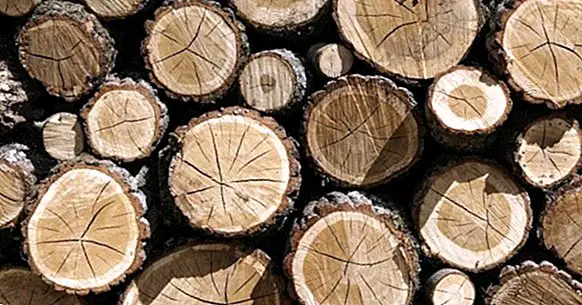Xilophobia: symptoms, causes and treatment
The xilofobia, also known as hilofobia , is the persistent and intense fear to the objects made with wood, or to the materials that simulate it, as well as to the wooded areas. Although it is rare, it is a specific phobia to a natural environment, which may be related to the hazards associated with forests.
Next, what is xylophobia as well as its main symptoms and some strategies to counteract.
- Related article: "Types of phobias: exploring the disorders of fear"
Xilophobia: fear of wood
The term xilofobia is composed of the Greek voice "xilo" (xylon), which means wood, and "fobos" which means fear. Is about a persistent and excessive fear of wood , its characteristics (smell, texture) and the objects that derive from it. It is also characterized by a fear of the forests and the materials that simulate wood.
Being a phobia whose trigger is an element of nature, xylophobia can be defined as a specific phobia to the natural environment. As such, it has been little or no investigation, since it manifests itself in low frequency .
What can happen more frequently is that it is a fear that is related to others, for example, of a situational type. The latter are fears that persist in certain circumstances or places, such as forests or open spaces. In this case, xylophobia can be related not only to wood, but also to darkness, wide-open spaces, uncertainty, animals, getting lost, and so on.
Characteristics and main symptoms
When we are faced with situations that represent a danger, whether real or perceived , our body alerts us in different ways. Specifically activates a part of our nerve cells known as autonomic nervous system, which regulates the involuntary functions of our body.
These functions include, for example, visceral activity, respiratory rate, sweating or palpitations. All these reactions, which are related to fear, allow us to set in motion a series of adaptive behaviors, that is, they allow us to respond proportionally to possible harm.
But, it can also happen that the previous reactions are presented disproportionately, preventing us from generating adaptive responses and significantly impacting our experiences with respect to the stimulus.
Precisely, specific phobias such as xylophobia are characterized by a response from anxiety triggered by exposure to the stimulus that is perceived as harmful . Thus, xylophobia can be manifested through the following symptoms mainly: tachycardia, increased blood pressure, sweating, decreased gastric activity, palpitations, hyperventilation.
In the same way and in case of activating the part of the autonomic nervous system known as "parasympathetic nervous system", xylophobia can generate the physiological responses associated with disgust , such as cardiovascular deceleration, dry mouth, nausea, stomach pain, dizziness and decreased temperature.
The previous symptomatology varies according to whether the specific phobia is a situation, an environmental element, animals, wounds, or any other type. According to the case, another of the possible manifestations is the presence of a panic attack.
On the other hand, it is common the presence of secondary behaviors, which are those that the person performs to protect themselves from the noxious stimulus and prevent the anxiety response. Is about defensive and avoidant behaviors (do everything possible not to expose yourself to the harmful stimulus) and hypervigilance over situations or related elements. To this is added the perception of lacking resources to face the feared stimulus, which can aggravate the anxiety response and increase the avoidance behaviors.
Causes
As with other specific phobias, xylophobia can be caused by a series of associations learned about the stimulus and possible harm. In this case, it is about associations on forest areas and the elements that compose them (especially wood), and the related dangers.
These associations may be based on real and direct experiences of danger, or may have been set by indirect experiences. In the specific case of xylophobia, media exposure to wooded spaces can have an important influence, where they are usually represented in a close relationship with imminent dangers, for example, getting lost or being attacked by an animal or by someone.
When does a phobia develop?
In general, phobias of natural environment type begin in childhood (before age 12), and situational phobias can begin both in childhood and after 20 years . Similarly, it can happen that a specific phobia develops until adulthood, even when the non-persistent fear has begun since childhood.
The latter has not been studied in xylophobia, but in animal phobia, blood and injections, driving and heights. In addition, when development occurs during childhood and adolescence, phobic fears are more likely to decrease even without the need for treatment; issue that is more difficult to occur in adulthood. It is more common for specific phobias to occur in women than in men.
Main treatments
In the beginning it is important to evaluate the situation and the feared stimulus to determine the causes. From there, it's important detect problematic behaviors at the cognitive, physiological and social levels , as well as the intensity of the anxiety responses. later it is important to analyze the emotional resources and coping styles of the person to know what is necessary to reinforce or modify.
To intervene directly on xilophobia, as well as to treat other types of specific phobias, it is common to use strategies such as the following:
- Live exhibition.
- Participant model.
- Relaxation strategies .
- Cognitive restructuring.
- Imaginary exposure techniques .
- Systematic desensitization.
- Reprocessing by eye movements.
The effectiveness of each one depends on the specific type of phobia and the particular symptoms of those who have it.
Bibliographic references:
- Fritscher, L. (2018). Understanding Xylophobia or the Irrational Fear of Wooded Areas. Retrieved September 10, 2018. Available at //www.verywellmind.com/what-is-the-fear-of-the-woods-2671899.
- Bados, A. (2005). Specific phobias. Faculty of Psychology, University of Barcelona.



















